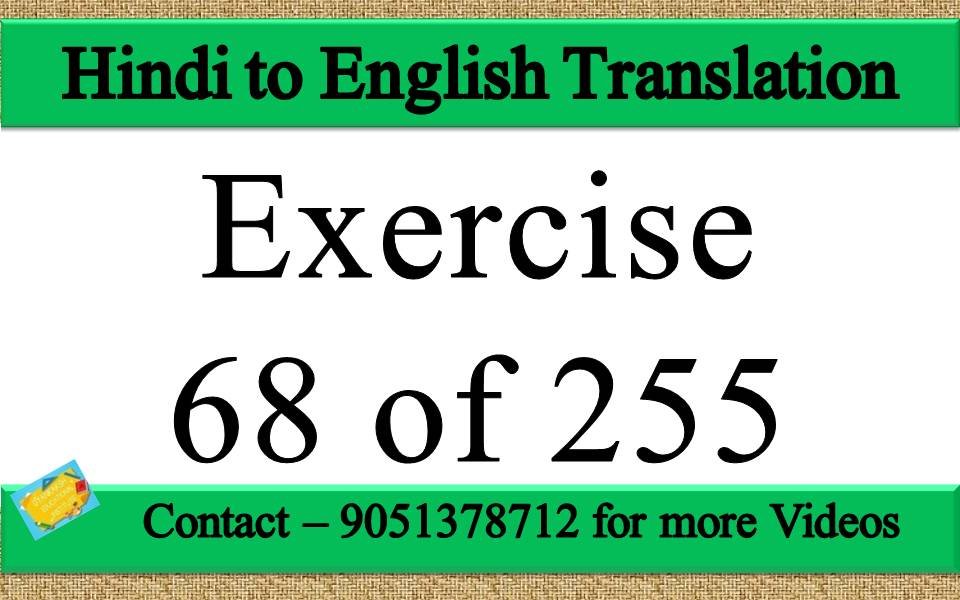"Mastering Translation: Unleash Your Skills with Hindi to English Translation Exercise 68"
Hindi to English Translation Course में आपका स्वागत है। इस Course में हम आपको 255 Exercises Solve करवाएंगे। अगर आप सभी Hindi to English Translation Exercise Solve करना चाहते है तो 9051378712 में सम्पर्क करें।
We have given you 255 classes on Hindi to English Translation Exercises. This is Hindi to English translation Exercise 68. You should watch the YouTube video first and then practice the sets given below. If you want proper improvement then practice by writing these sets in your copy and then study them regulary.
In every practice set you will get many examples on Hindi to English Translation Exercises with exercises, vocabulary and explanation.
We have given many course on Spoken English in our website. You can get them from the menu section.
Table of Contents (Hindi to English translation)
Hindi to English Translation Exercise 68 of 255
Do Hindi to English Translation:
मैं पढ़ता हूँ।
हम (लोग) खेलते हैं।
तुम (लोग) जानते हो।
रवि गाता है।
नेहा नाचती है।
वे (लोग) हँसते हैं।
आप (लोग) पढ़ाते हैं।
राजेश पढ़ता है।
राजेश और राहुल पढ़ते हैं।
गाय रंभाती है।
गायें रंभाती हैं।
मैं दौड़ता हूँ।
मेरा भाई दौड़ता है।
आप हँसते हैं।
आपके बच्चे हँसते हैं।
वह जानता है।
उसके मित्रगण जानते हैं।
वह नाचती है।
उसकी बहनें नाचती हैं।
भेड़ मिमियाती है।
भेड़ें मिमियाती हैं।
रश्मि गाती है।
रश्मि और शालिनी गाती हैं।
बिल्ली म्याऊँ – म्याऊँ करती है।
बिल्लियाँ म्याऊँ – म्याऊँ करती हैं।
हम लोग पढ़ते हैं।
वह पढ़ाता है।
बाघ दहाड़ता है।
बाघ दहाड़ते हैं।
Download our Mobile App from Google Play Store – Gyankaksh Educational Institute.
Vocabulary for Hindi to English Translation Exercise 68 of 255:
पढ़ना – to read,
खेलना – to play,
जानना – to know,
गाना – to sing,
नाचना – to dance,
हंसना – to laugh,
पढ़ाना – to teach,
रंभाना – to low / to moo,
दौडना – to run,
मिमियाना – to bleat,
म्याऊँ – म्याऊँ करना – to mew,
दहाड़ना – to roar.
Spoken English Course (Beginner level to advance level) 2500+ Videos
- Tense
Tense (काल) से किसी कार्य के होने का समय का पता चलता है।
Tense (काल) के तीन भेद हैं:
- Present Tense (वर्तमानकाल)
- Past Tense (भूतकाल)
- Future Tense (भविष्यत्काल)
पुनः इन तीनों के चार – चार भेद हैं। Present Tense के चार भेद हैं:
- Simple Present Tense (सामान्य वर्तमानकाल)
- Present Continuous Tense (सातत्यबोधक वर्तमानकाल)
- Present Perfect Tense (पूर्ण वर्तमानकाल)
- Present Perfect Continuous Tense (सातत्यबोधक पूर्ण वर्तमानकाल)
इसी प्रकार, Past Tense और Future Tense के भी चार – चार भेद हैं।
Simple Present Tense (सामान्य वर्तमानकाल)
यदि वाक्य की क्रिया के अंत में ता हूँ / ती हूँ / ते हो / ती हो / ता है / ती है / ते हैं / ती हैं हो और वाक्य के भाव से यह बोध हो कि कार्य वर्तमान समय में सामान्यतया होता है, तो इसका अर्थ है कि वाक्य की क्रिया Simple Present Tense (सामान्य वर्तमानकाल) में है।
नीचे दी गई सारणी का ध्यानपूर्वक अध्ययन करें:
Person (पुरुष) | Singular (एकवचन) | Plural (बहुवचन) |
First Person (उत्तम पुरुष) | I read. मैं पढता हूँ। मैं पढ़ती हूँ। | We read. हम (लोग) पढ़ते है। हम (लोग) पढ़ती है। |
Second Person (मध्यम पुरुष) | You read. तुम पढ़ते हो। तुम पढ़ती हो। आप पढ़ते है। आप पढ़ती है। | You read. तुम लोग पढ़ते हो। तुम लोग पढ़ती हो। आप लोग पढ़ते है। आप लोग पढ़ती है। |
Third Person (अन्य पुरुष) | He reads. वह पढता है।
She reads. वह पढ़ती है।
It reads. वह पढता है।
Rabi reads. रवि पढता है।
Neha reads. नेहा पढ़ती है। | They read. वे (लोग) पढ़ते है।
The boys read. लड़के पढ़ते है।
The girls read. लड़कियां पढ़ती है। |
ऊपर की सारणी से स्पष्ट है कि Subject (कर्ता) के बाद Verb (क्रिया) के Base Form (मूल रूप) का व्यवहार होता है। परंतु Subject यदि Third Person (अन्य परुष) के Singular Number (एकवचन) में हो, तो Verb में – s / – es जोड़ दिया जाता है।
Note: Simple Present Tense को Present Indefinite Tense (अनिधित वर्तमानकाल) भी कहा जाता है।
अब आप विभिन्न प्रकार के वाक्यों के अंग्रेजी अनुवाद में Simple Present Tense का व्यवहार देखेंगे।
Affirmative Sentences (सकारात्मक वाक्य)
Structure: Subject + Verb (Base Form) + ( – s / – es) + other words.
नीचे के वाक्यों को ध्यान से पढ़ें:
1. मैं खेलता हूँ। | I play.
|
2. हम (लोग) पढ़ते हैं। | We read.
|
3. तुम (लोग) खाते हो। आप (लोग) खाते हैं। | You eat.
|
4. वह जाता है। | He goes.
|
5. वह आती है। | She comes.
|
6. वे (लोग) दौड़ते हैं। | They run.
|
7. राजेश और राकेश हँसते हैं। | Rajesh and Rakesh laugh.
|
8. गाय चरती है। | The cow grazes.
|
9. गायें चरती हैं। | Cows graze.
|
10. कुत्ता भूँकता है। | The dog barks.
|
11. कुत्ते भुंकते हैं। | Dogs bark.
|
12. मेरी बहन गाती है। | My sister sings.
|
13. मेरी बहनें गाती हैं। | My sisters sing. |
Thank you for watching Hindi to English translation Exercise 68 of Hindi to English Translation Exercises. Please give us your feedback in the comment section below. We would love to know about your thoughts on our content. Feel free to share your thoughts with us in the comment section. Moreover, you can give us your valuable suggestions or advice for improving our content.
We would love to read your comments. Thank you!
If you liked this article of Hindi to English translation Exercise 68, then please share it with your friends and relatives on WhatsApp, Facebook, etc.
Thank you!
Raghunath Sir!


